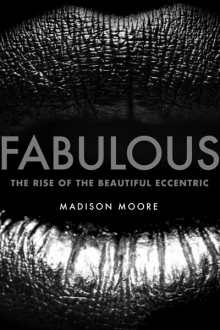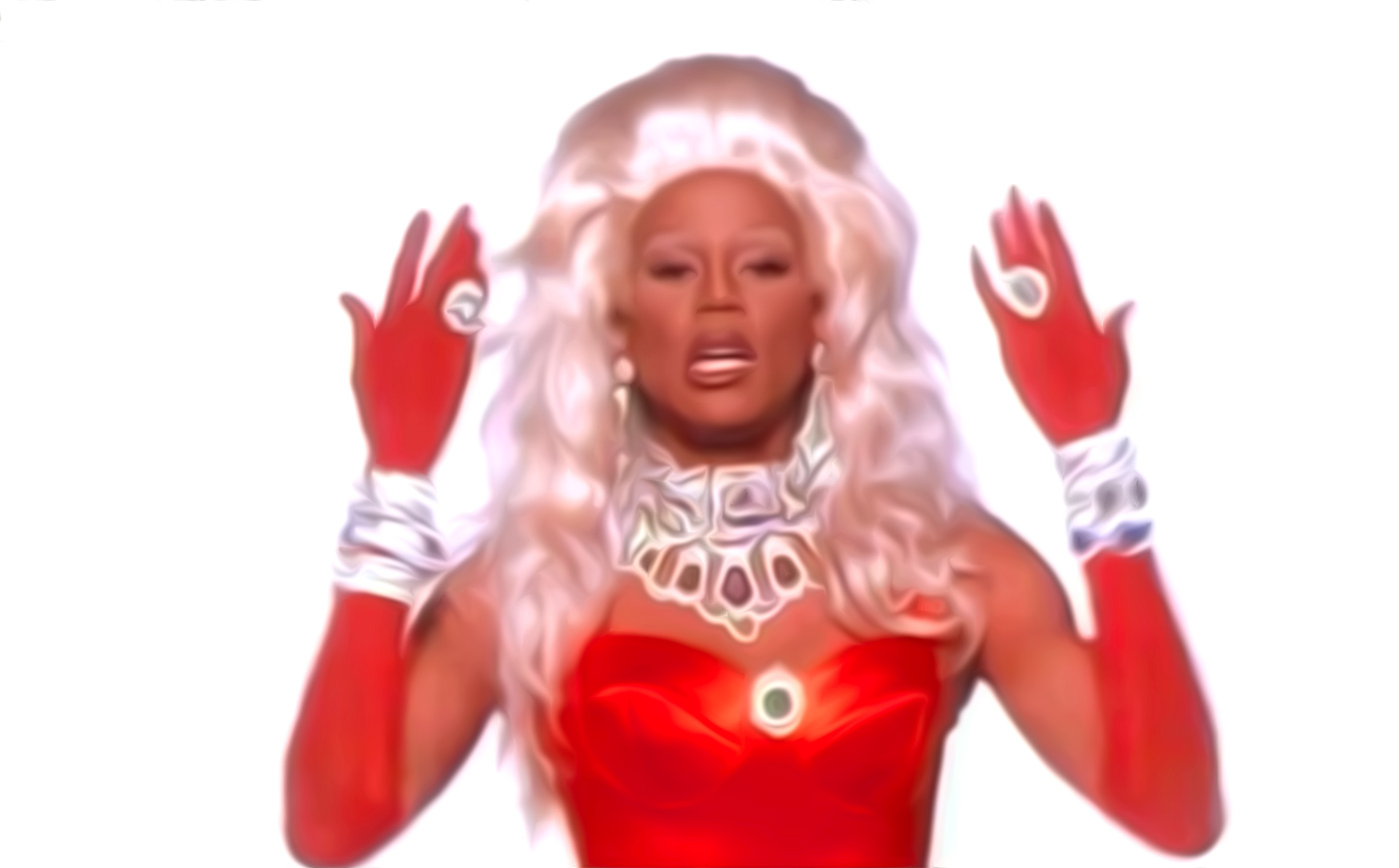When RuPaul exhorts listeners to work in the record “Supermodel (You Better Work),” this work is really labor. To obey this command is not only to perform the mechanical work of posing, strutting, or sashaying. As labor, to “work, supermodel” is to produce something that was not there before. For cultural critic, DJ, and scholar madison moore, that product is fabulousness, and illuminating the continually erased labor behind it is the subject of his intriguing new monograph, Fabulous: The Rise of the Beautiful Eccentric. Part history of ballroom culture, part field notes from the world’s most fabulous queer nightclubs, Fabulous puts forward a theory of how to “work, supermodel.”

madison moore, Fabulous: The Rise of the Beautiful Eccentric. Yale University Press, 2018. 280 pages.
“As a queer aesthetic category, fabulousness requires aesthetic labor,” moore writes. But, “what does it mean in this context to tell a brown body, a body frequently exploited for labor, to work?” This question foregrounds a seeming capitulation to capitalism at play in ballroom, at least as it’s captured in Jennie Livingston’s documentary Paris Is Burning, which portrays a black and brown queer subculture seemingly enamored with whiteness and conspicuous consumption. This is even the case, to some degree, in Pose: the second episode is titled “Access”—to the privileged spaces of the white, cisgendered, capitalist class.
Almost 30 years later, the situation Livingston captured and that Pose reimagines appears to be reversed. Moneyed heterosexuals spend thousands of dollars on tables to see drag performances at certain Lower East Side venues in New York. Elite queer spaces police their doors with caprice, a behavior that appears to be hardly of a piece with any spirit of solidarity. What’s more, the commercial success and mainstream appeal of RuPaul’s Drag Race have commodified elements of ballroom, such as shade and reading: The “next drag superstar” is a brand, and being fabulous functions as an entrée to fame and fortune.
To be clear, this is not to suggest drag and ballroom are synonymous, nor is it to suggest the acclaim and prosperity of a televised drag pageant, one conceived and championed by a black gay man, is somehow counterproductive for queer people, and queer people of color especially. Rather, it’s merely to underscore the point that ballroom has been (and can continue to be) construed as a spectacular symptom of capitalism, whether as its victim (then) or its volunteer (now). Of what use, then, is ballroom, voguing, fabulousness, and beautiful eccentricity to a critique of capitalism? Or white supremacy? Or heteronormativity?
But, perhaps these questions have less to do with a failure of ballroom to be subversive and more to do with the white-centric media that have, until now, been ballroom’s main point of encounter with outside communities. As moore points out, ballroom, voguing, and their vivifying energy, fabulousness, are fundamentally misunderstood in large part because their history has not been told by members of the black and brown communities that created them. Hence, the so-called “return of voguing” that is periodically announced in global media. Seeking to correct the record, moore uses this book to build an “archive of fabulousness” through which ballroom begins to appear less as a symptom or servant of capitalism and more as a shelter from it.
In four chapters that stand alone as individual essays, moore traces the history of ballroom culture, theorizes its aesthetics, and documents its ongoing evolution. His accessible style adroitly combines engagement with dozens of thinkers with delightful asides (“I love a shoulder pad”—me too), and provides context and genealogy for the smallest nuances of ballroom. Under moore’s scrutiny, even a reliably well-known phrase like “step your pussy up” has a clear line of descent, in this case to “TS Madison, a popular black trans activist, adult entertainer, and YouTube personality.”
Such palpable affection for the individuals putting their marks on contemporary ballroom permeates Fabulous. Drawing on author Richard Wright’s directive in “Blueprint for Negro Writing” that “no theory of life can take the place of life,” moore supplements his scholarly prose with his first-person anecdotes, as well as interviews with famous fixtures of queer nightlife. Dozens of DJs, musicians, dancers, and other artists—most of them queer people of color—populate the book. Fabulous thus often reads like a feature profile, a form moore has expertise in, having written for Out, the lifestyle magazine geared toward gay men, and Interview, Andy Warhol’s now defunct celebrity culture magazine.
Four subjects receive special attention: Alok Vaid-Menon, a transfeminine multimedia performance artist; an “untenured black female scholar” who remains anonymous; Shaun J. Wright, a DJ, vocalist, and producer; and Lasseindra Ninja, Mother of the Paris branch of the ballroom House of Ninja. After each of the chapters, which advance moore’s historical and aesthetic arguments, he includes a conversation with one of these people, recounting recent ballroom events in Berlin and Paris, as well as efforts underway to educate younger, whiter audiences in those cities about the origins of ballroom. These discussions are among the most valuable and productive scholarly interventions moore makes with Fabulous, writing the voices of the contemporary ballroom community into history.
This structure can cause the book to become repetitive, even cumbersome: moore cites these same individuals frequently elsewhere in the book, beyond the transcribed conversations. At times, I found myself wondering if I had already read a section, only to find out that indeed I had. Still, as cliché as it may be to say so, repetition is an effective teacher, and moore’s redundancy reinforces the critical point that ballroom culture must maintain continuity with the political and historical conditions that created it. Any deracination is unconscionable for moore, who is emphatic about the political stakes of fabulousness:
The stakes . . . are that at the same time that brown, queer, and trans bodies express, feel good about, and expand ourselves through fabulousness and self-styling, that joy is subject to surveillance, torture, and ridicule by homonormative, heteronormative, misogynist, and patriarchal systems every single day, from the workplace to our living rooms and from the dating app to the sidewalk.
To separate fabulousness from its black and brown queer origins is to annihilate its power. This fatal cauterization is a real and present threat in Europe, moore observes, in nascent ballroom scenes “that are too often spearheaded by white straight female professional dancers.” In Russia, Slovakia, the Netherlands, and Sweden, among others, vogue is considered a choreography to be mastered rather than act of resistance by a certain kind of body, eliminating what moore calls its function as a “poetics of the self.” Technology exacerbates the problem, as Vjuan Allure, a major house/ballroom circuit DJ says in the book regarding YouTube voguers: “You’re not really voguing. You’re not thinking in your head what my moves are. You can tell when it’s not your performance, when it’s somebody else’s performance that you saw.”
This trend testifies not only to the persistent popularity and promiscuity of vogue but also to the pernicious creep of white supremacy over it. “The origin of vogue was about creating black queer space, a safe space, for the brown gay community to express themselves,” moore reiterates. “It was never about dance studios.” As ballroom and vogue continue to spread across the world, moore’s iconoclastic book is an urgent reminder of the risks that must be managed. Preserving the black and brown queer origins of ballroom is nonnegotiable.
For moore, being fabulous is “a constellation of beauty and pain, of virtuosic creativity and risk” that can only be fully synthesized by black and brown queer creators. It’s unclear if this means that white and/or nonqueer persons can be fabulous at all, or just incompletely so. Regardless, moore contends that by virtue of this origin, fabulousness is an aesthetic and political practice that can not only critique capitalism, white supremacy, and heteronormativity but also offer ephemeral escape from them.
Consider “working a look,” a fabulous act. For moore, to work a look is to become visible in a world that prefers you to be invisible, and to do so in spite of the bodily risks of transgression. Fabulousness emerges when a marginalized person pushes back against the driving force of that marginalization (white supremacy, heteronormativity, capitalism, etc.) by radically styling themselves to become unavoidable to strangers’ eyes. As such, the look “demands space,” seizing it by force through, for example, wigs that overwhelm the body and expand its perimeters, transforming the wearer into an unavoidable spectacle. Such a look, truly fabulous, demands being seen, marshaling light with glitter and sequins. It demands time, disrupting the “boredom” and monotony of capitalism with spectacle. Most importantly, it demands presence for black, brown, queer subjects—and it demands it now. “With fabulousness, dreams and theories of stylish utopias are yanked from the future and brought to the present,” moore writes.
Though he believes in the power of this utopia, moore is candid that fabulousness and the whole infrastructure of the ballroom circuit will not undo structural racism or heteronormativity, nor will they pay the rent or threaten capitalism systematically. Nonetheless, for moore, the fact remains that these forces may never be sufficiently overcome. “My point is,” he writes, “that it’s even more demeaning to ask folks whom society marginalizes to wait, hold on, and be still until things are amazing, perfect, and utopian once and for all before they can express themselves. What if that day never comes?”
The question is repeated over and over throughout the text, and rightfully so, but moore does not take any opportunity to consider what role fabulousness, voguing, and their expanding influence may have in ensuring that this day does arrive. This isn’t an entirely unexpected omission: moore’s task here was to create an “archive of fabulousness” and chart the “rise of the beautiful eccentric,” which are necessarily backward-looking endeavors. Still, the neglect of such an obvious and compelling question causes the text to feel incomplete. And perhaps it is incomplete as a piece of scholarship. But as a piece of cultural criticism of the present, when the vital history of ballroom is still all too obscure to far too many people who regularly appropriate its language and practices, Fabulous satisfies a timely need.
As moore writes, “Why do brown and trans bodies matter only when they’re fabulous or on a stage? What if instead of telling the brown or trans person, ‘Wow, you’re fabulous,’ you fought for them? What if you stood up for us in real life when someone calls us a faggot or physically harasses us on the street? . . . We look amazing—thank you—but why aren’t you fighting for us?” While we cannot all truly “work, supermodel,” moore’s request here is far more reasonable: It’s the work in “work, supermodel” that we all can and must do.
